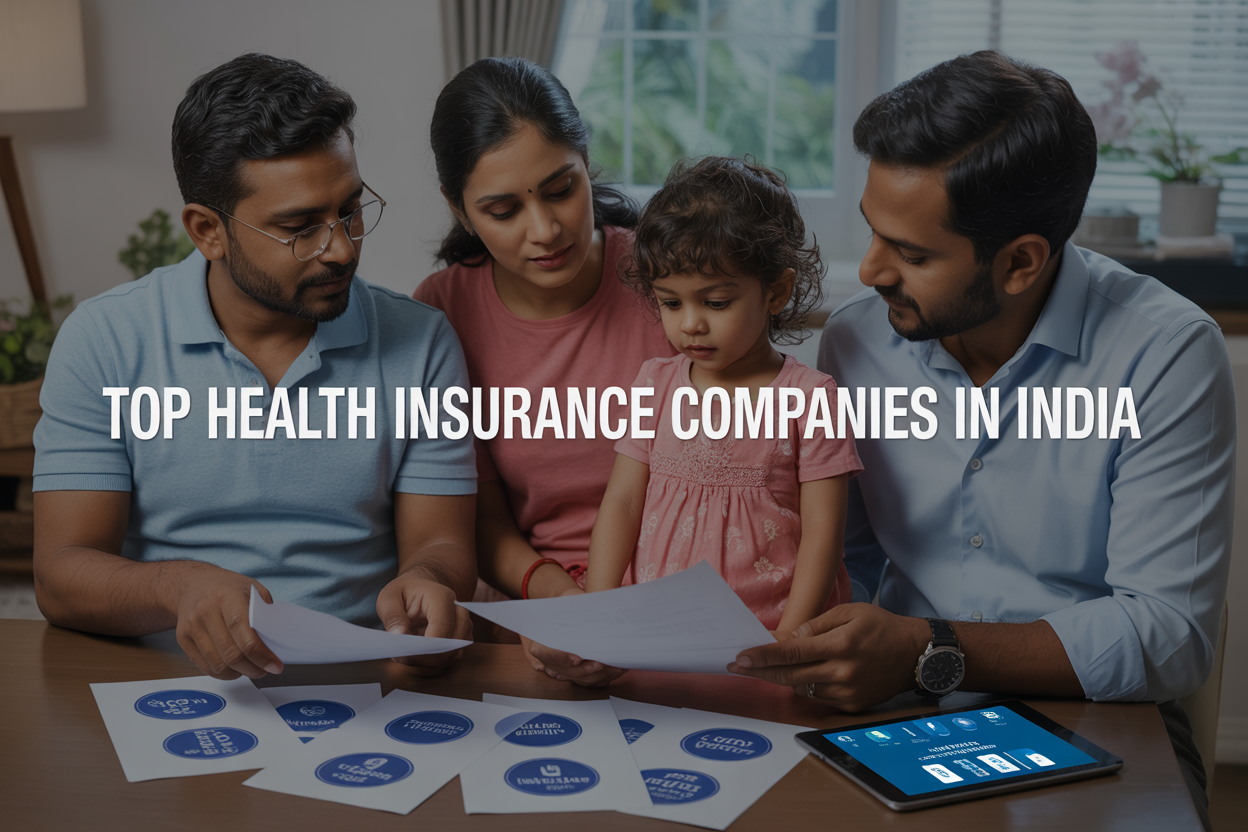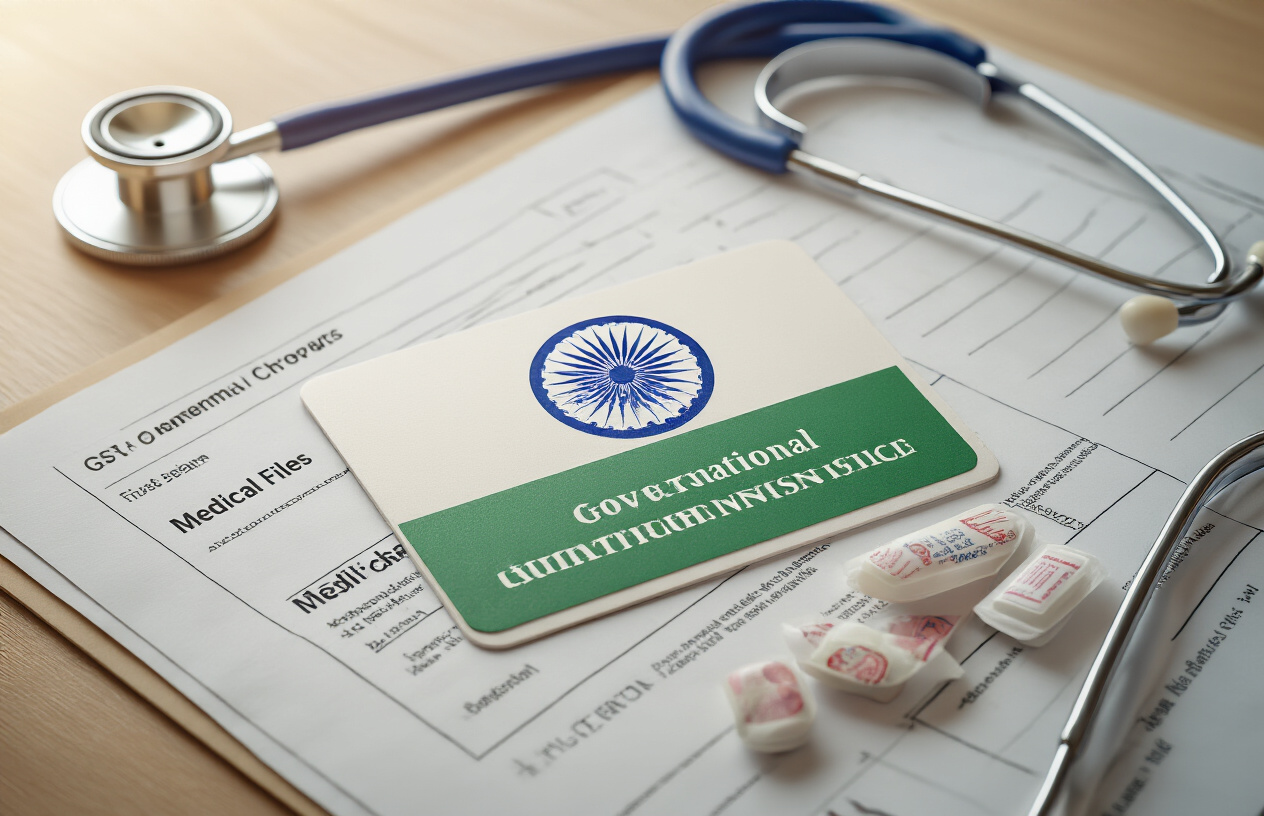
Ever had that sinking feeling when a medical emergency strikes and you realize your savings might not cover it? You’re not alone. With healthcare costs skyrocketing, finding the right health insurance companies in India can literally be a lifesaver.
Think about it – one hospital stay could wipe out years of careful saving. That’s why 60% of Indians who face bankruptcy cite medical bills as the primary cause.
I’ve spent weeks analyzing coverage options, premium structures, and claim settlement ratios so you don’t have to waste precious time comparing policies that won’t deliver when you need them most.
But here’s what most people get wrong about health insurance – it’s not just about picking the cheapest premium. The real question is: which company will actually have your back when things go sideways?
table of contents
Understanding Health Insurance in India

Why health insurance is essential for Indians
Medical emergencies don’t send warning texts. They crash into your life without notice, leaving emotional and financial wreckage in their wake.
Consider this: a single hospitalization for a serious illness can cost anywhere from ₹3-5 lakhs in a private hospital. Without insurance, that’s coming straight from your savings—or worse, pushing you into debt.
The scary truth? About 6 crore Indians fall below the poverty line every year due to healthcare expenses. That’s more than the entire population of South Korea.
Health insurance isn’t just another financial product—it’s your safety net when life decides to test you. With rising medical inflation (currently at 14-15% annually), treatment costs are skyrocketing faster than your salary increments ever will.
Think about these real benefits:
- Cashless treatment at network hospitals
- Coverage for pre and post-hospitalization expenses
- Tax benefits under Section 80D (up to ₹75,000 for senior citizens)
- Protection against lifestyle diseases that are increasingly common
With healthcare costs climbing and lifestyle diseases becoming more prevalent, health insurance isn’t optional anymore—it’s as essential as your smartphone.
Key factors to consider when choosing a provider
Shopping for health insurance can feel like deciphering ancient hieroglyphics. Here’s what actually matters:
Network hospitals: What good is insurance if you can’t use it nearby? Check if your preferred hospitals are covered before signing anything.
Claim settlement ratio: This number tells you how often the insurer actually pays out claims. Look for ratios above 90% – anything lower is a red flag.
Waiting periods: Most insurers won’t cover pre-existing conditions immediately. Some make you wait 2 years, others 4. Huge difference when you’re already managing a condition.
Sub-limits and room rent caps: Some policies limit how much they’ll pay for specific treatments or restrict you to certain room types. These hidden clauses can burn your wallet when you least expect it.
Restoration benefits: The best policies restore your sum insured if you exhaust it during the policy year. Think of it as an extra life in a video game.
Portability options: Your relationship with your insurer might not last forever. Check how easily you can switch to another company without losing benefits.
The fine print matters more than the premium. A slightly more expensive policy with fewer exclusions often saves you more in the long run.
Public vs private health insurance options
The healthcare landscape in India offers two main paths: government schemes and private insurance. Each comes with its own flavor of advantages and limitations.
Government schemes like Ayushman Bharat-PMJAY provide coverage up to ₹5 lakhs per family annually—targeting the bottom 40% of India’s population. It’s a lifeline for those who couldn’t otherwise afford care.
Other public options include:
- CGHS for central government employees
- ESIC for organized sector workers earning up to ₹21,000 monthly
- State government schemes like Tamil Nadu’s Chief Minister’s Comprehensive Health Insurance
Private insurance, meanwhile, offers more flexibility, wider hospital networks, and higher coverage limits—but at premium prices.
| Aspect | Public Insurance | Private Insurance |
|---|---|---|
| Coverage amount | Limited (typically ₹1-5 lakhs) | Higher (up to ₹1 crore available) |
| Premium cost | Low or free for eligible citizens | Higher, age and health-dependent |
| Hospital network | Limited, mostly government hospitals | Extensive, includes premium facilities |
| Claim process | Often paper-heavy and time-consuming | Usually smoother with digital options |
| Waiting periods | Generally shorter | Can be longer for specific conditions |
The ideal approach? Many families combine both—using government schemes as a base layer and adding private insurance for additional protection and access to better facilities.
Top Government Health Insurance Schemes

Ayushman Bharat – Pradhan Mantri Jan Arogya Yojana
Looking for comprehensive health coverage without burning a hole in your pocket? Ayushman Bharat-PMJAY might be your answer.
Launched in 2018, this game-changing government scheme covers over 10.74 crore poor and vulnerable families (approximately 50 crore beneficiaries). The best part? Each family gets coverage up to ₹5 lakhs per year for secondary and tertiary care hospitalization.
What makes PMJAY stand out is its sheer scope. It covers pre and post-hospitalization expenses, including medicines, diagnostic services, and follow-up care. No restrictions on family size, age, or pre-existing conditions means everyone gets protection.
The scheme operates through a network of empanelled hospitals across India. If you’re eligible, you’ll receive an e-card that gives you cashless treatment at these facilities.
Employees’ State Insurance Scheme (ESIS)
Been working in the organized sector with a monthly salary under ₹21,000? ESIS has your back.
This self-financing social security scheme covers employees and their families with comprehensive medical care. The beauty of ESIS is its contribution model – employers contribute 3.25% while employees chip in just 0.75% of their wages.
ESIS doesn’t just stop at hospitalization. It offers everything from primary healthcare to specialized treatments, maternity benefits, disability benefits, and even dependents’ benefits in case of job-related deaths.
With over 160 hospitals and 1,500+ dispensaries across India, ESIS ensures you’re never far from quality healthcare. The scheme serves approximately 3.49 crore insured persons and their family members.
Central Government Health Scheme (CGHS)
Working for the central government has its perks, and CGHS tops that list.
Established in 1954, CGHS provides comprehensive healthcare to central government employees, pensioners, and their dependents. Available in 71 cities through 329 wellness centers, it’s designed to be accessible wherever you go.
The scheme offers both allopathic and alternative medicine options including Ayurveda, Yoga, Unani, Siddha, and Homeopathy. This gives you flexibility in choosing treatment approaches that work best for you.
CGHS operates on a contribution basis determined by your pay grade, with rates ranging from ₹250 to ₹1,000 per month. Pensioners pay a slightly different rate.
State-specific health insurance programs
Beyond national schemes, many states run their own health insurance programs tailored to local needs.
Tamil Nadu’s Chief Minister’s Comprehensive Health Insurance Scheme covers 1.58 crore families with benefits up to ₹5 lakhs. Karnataka’s Yashaswini Scheme focuses on rural cooperative members, while Kerala’s Karunya Health Scheme helps patients with life-threatening conditions.
Maharashtra’s Mahatma Jyotiba Phule Jan Arogya Yojana provides coverage up to ₹1.5 lakhs for economically vulnerable families. Meanwhile, Andhra Pradesh and Telangana operate the Aarogyasri scheme covering treatments worth up to ₹2.5 lakhs.
These state schemes often complement national programs, ensuring wider coverage and addressing region-specific healthcare challenges.
Leading Private Health Insurance Companies

Star Health Insurance – Pioneering Specialized Coverage
Looking for a health insurer that actually understands specific medical needs? Star Health stands out from the pack. They’ve built their reputation on offering targeted plans that most competitors simply don’t have.
Their cancer insurance plans? Game-changers. While other companies treat cancer coverage as just another illness, Star Health created dedicated policies that cover the full spectrum of cancer treatment – from diagnosis through recovery.
Their senior citizen plans aren’t afterthoughts either. They’ve eliminated those annoying age-related premium hikes that plague most elderly policyholders. Plus, they offer coverage for pre-existing conditions after just one year, not the industry-standard two.
What really sets them apart is their autism coverage – still a rarity in India. Parents of children with autism can finally access specialized care without emptying their savings.
HDFC ERGO – Digital-First Approach to Claims
HDFC ERGO has completely reinvented the claims process. Remember when filing a claim meant drowning in paperwork? Not anymore.
Their mobile app lets you submit claims with just a few taps. Upload your bills, track your claim status in real-time, and get updates via notifications. No more endless phone calls wondering where your reimbursement is.
They’ve introduced AI-powered claims processing that can approve straightforward claims in minutes, not days. Their chatbot handles basic queries instantly, freeing up human agents for the complex stuff.
What I particularly love is their digital health wallet. All your medical records, prescriptions, and policy details in one secure place. No more frantic searches for that important document when you need it most.
ICICI Lombard – Comprehensive Family Floater Plans
ICICI Lombard has cracked the code on family coverage. Their family floater plans are some of the most flexible in the market.
They offer coverage for up to 19 relationships under a single policy – grandparents, parents-in-law, siblings – basically everyone who matters. Most insurers cap this at 6-8 family members.
Their plans include unique features like OPD coverage without sublimits. Doctor consultations, diagnostic tests, and medications are covered from day one – no waiting periods.
The restoration benefit automatically replenishes your sum insured if it gets exhausted during the policy year. And unlike competitors who only restore for different illnesses, ICICI Lombard restores it even for the same condition.
Bajaj Allianz – Extensive Hospital Network
Bajaj Allianz boasts the largest hospital network in India, with over 6,500 partnered facilities. This means cashless treatment virtually anywhere you go.
They’ve gone beyond just partnering with hospitals. Their network includes specialized care centers, rehabilitation facilities, and even home healthcare providers. Complete coverage, regardless of where you receive treatment.
Their network spans beyond tier-1 cities into smaller towns, addressing a major pain point for rural policyholders who typically struggle with cashless options.
Max Bupa – Innovative International Coverage Options
Max Bupa is changing the game for international coverage. Their global health plans don’t just cover emergency treatment abroad – they provide comprehensive care options worldwide.
Their ReAssure plan offers unlimited sum insured for critical illnesses, both in India and internationally. Most competitors cap international coverage at a fraction of your total sum insured.
They’ve introduced multi-currency claims settlement, eliminating those expensive forex conversion charges. Get reimbursed in dollars, pounds, or euros – whichever currency you paid in.
Comparing Premium Health Insurance Plans

Best plans for family coverage
Finding the right health insurance for your family isn’t just about ticking a box. It’s about peace of mind.
Star Health’s Family Health Optima stands out with coverage up to ₹25 lakhs and includes all family members under a single sum insured. The beauty? No separate premium calculations needed for each person. They even throw in free health check-ups after two claim-free years.
HDFC ERGO’s My:Health Suraksha Family Floater offers something different – restoration benefits that refill your coverage amount if you use it up during the policy year. Perfect for families with multiple medical needs.
For growing families, consider Bajaj Allianz’s Family Floater Health Guard. It covers maternity expenses after a 3-year waiting period and includes newborn babies from day one.
Here’s a quick comparison:
| Plan | Coverage Limit | Key Feature | Waiting Period |
|---|---|---|---|
| Star Health Family Optima | Up to ₹25L | Free health check-ups | 2 years for pre-existing |
| HDFC ERGO My:Health | Up to ₹50L | Restoration benefit | 3 years for pre-existing |
| Bajaj Allianz Health Guard | Up to ₹20L | Maternity coverage | 3 years for maternity |
Top options for senior citizens
Insurance companies often shy away from seniors. But some plans actually cater specifically to our parents and grandparents.
National Insurance’s Varistha Mediclaim targets those 60+ with coverage up to ₹15 lakhs and includes pre-existing diseases after just one year (compared to the usual 2-4 years). They also cover health check-ups and domiciliary treatment.
The Star Health Senior Citizens Red Carpet plan covers people up to 75 years at entry and offers lifetime renewability. Their automatic restoration benefit is a game-changer when seniors face multiple hospitalizations.
ICICI Lombard’s iHealth for seniors includes coverage for joint replacement surgeries after just two years and offers no-claim bonuses that increase sum insured by 10% annually.
| Plan | Entry Age | Pre-existing Coverage | Unique Benefit |
|---|---|---|---|
| National Varistha | 60-80 years | After 1 year | Domiciliary treatment |
| Star Red Carpet | Up to 75 years | After 1 year | Lifetime renewability |
| ICICI iHealth | 60-75 years | After 2 years | Joint replacement coverage |
Specialized plans for chronic conditions
Chronic conditions need special attention in health insurance. Several insurers now offer tailored plans that don’t treat pre-existing conditions as exclusions.
Care Health Insurance’s Care Freedom plan stands out by covering diabetes and hypertension from day one. No waiting periods. They even cover regular check-ups and medication costs related to these conditions.
Apollo Munich’s Energy plan specifically covers diabetes with benefits including quarterly medical check-ups and coverage for complications arising from diabetes.
Star Health’s Diabetes Safe plan covers both Type 1 and Type 2 diabetes and includes regular consultations with specialists.
| Plan | Conditions Covered | Day 1 Coverage | Medication Coverage |
|---|---|---|---|
| Care Freedom | Diabetes, Hypertension | Yes | Partial |
| Apollo Energy | Diabetes | After 30 days | Yes |
| Star Diabetes Safe | Type 1 & 2 Diabetes | After 90 days | For hospitalization only |
Critical illness coverage comparison
Critical illness plans pay a lump sum when diagnosed with specified serious conditions. This amount isn’t tied to actual medical expenses – use it however you need.
Max Bupa’s Critical Illness Rider covers 20 critical illnesses including cancer, kidney failure, and major organ transplants with a one-time payout of up to 100% sum insured.
HDFC ERGO’s Critical Illness plan covers 15 illnesses but has shorter waiting periods (90 days compared to the usual 180) and offers tax benefits under Section 80D.
SBI General’s Critical Illness Insurance stands out with coverage for 13 conditions and the option to choose coverage up to ₹50 lakhs without any co-payment requirements.
| Plan | Conditions Covered | Waiting Period | Maximum Coverage |
|---|---|---|---|
| Max Bupa Rider | 20 illnesses | 180 days | ₹50 lakhs |
| HDFC ERGO Critical | 15 illnesses | 90 days | ₹40 lakhs |
| SBI Critical | 13 illnesses | 90 days | ₹50 lakhs |
Digital Transformation in Health Insurance

Mobile apps revolutionizing claims processing
Gone are the days of endless paperwork and hospital visits just to file a claim. Insurance companies in India have finally caught up with the digital wave, and their mobile apps are changing the game.
Take HDFC ERGO’s mobile app, for instance. You can now snap photos of your medical bills, upload them directly, and track your claim status in real-time. No more anxious phone calls to customer service!
Star Health’s app goes a step further with their 15-minute claim settlement promise for specific treatments. That’s right—money back in your account while you’re still recovering.
The best part? These apps are actually user-friendly. Remember when filing a claim meant drowning in jargon and complicated forms? The new interfaces guide you step-by-step, with most claims requiring just 3-4 screens of input.
What’s really making waves is the AI-powered verification. Apps from companies like Bajaj Allianz can now automatically verify hospital bills against standard treatment costs, flagging discrepancies instantly rather than rejecting claims weeks later.
Paperless policies and their benefits
The shift to paperless policies isn’t just good for trees—it’s transforming how we manage our health coverage.
Digital policies mean instant access. Lost your policy document before a hospital admission? No sweat. Pull it up on your phone and you’re good to go.
The savings are substantial too. Insurance companies pass some of their operational cost reductions to customers—many offering 5-10% discounts for going paperless.
Storage and organization become effortless. No more digging through filing cabinets for that one document. Everything’s searchable, categorized, and available with a few taps.
Policy updates happen in real-time. Remember when insurers mailed endorsements that sometimes got lost? Now changes reflect immediately in your digital document.
Security has improved dramatically too. While paper policies can be damaged or lost, digital ones come with encryption and multi-factor authentication. Companies like Max Bupa even provide blockchain-verified policy documents that can’t be tampered with.
Telemedicine integration with insurance plans
The marriage between telemedicine and insurance might be the most significant shift we’ve seen yet.
Most leading insurers now cover virtual consultations. Manipal Cigna and Apollo Munich were early adopters, but nearly all major players have followed suit—especially after COVID made remote healthcare essential.
The integration goes beyond just covering video calls. Many plans now include:
- Built-in teleconsultation apps with dedicated doctor networks
- Preferential rates for subscribers
- Pre-approval automation for prescribed treatments
- Digital prescriptions that link directly to home delivery pharmacies
What’s truly innovative is how some insurers are using telemedicine to reduce premiums. Aditya Birla Health Insurance offers lower rates if you opt for their “doctor first” approach—consulting virtually before heading to a hospital.
The data shows people love it. Customers using integrated telemedicine services report 30% higher satisfaction scores according to recent IRDAI surveys.
How to Choose the Right Health Insurance Provider

A. Assessing claim settlement ratios
When shopping for health insurance, don’t get dazzled by flashy marketing. Look at the numbers that really matter – like claim settlement ratios.
This ratio tells you how many claims a company actually pays out compared to the total claims received. It’s basically your “Will they pay when I need them?” indicator.
A high ratio (90% and above) suggests the insurer doesn’t look for excuses to reject claims. If a company has a settlement ratio below 80%, that’s a red flag waving frantically in your face.
Where do you find these numbers? The Insurance Regulatory and Development Authority of India (IRDAI) publishes annual reports with this data. You can also check the insurer’s website or annual reports.
Remember though, ratios can be misleading if taken alone. A company might have a high ratio because they deal with mostly simple claims, while another might handle more complex cases.
B. Evaluating hospital networks and cashless facilities
Picture this: You’re sick and need hospitalization. Would you rather:
- Pay from your pocket and wait months for reimbursement
- Just flash a card and walk in for treatment
I’m guessing option 2 sounds better. That’s cashless treatment for you.
The size and quality of an insurer’s hospital network directly impacts your healthcare experience. Before signing that policy, check:
- How many network hospitals are near your home and workplace?
- Are the best hospitals in your city included?
- Does the network cover hospitals in cities you frequently visit?
Some insurers boast thousands of network hospitals but might have gaps in your specific area. Others might have fewer hospitals overall but better coverage where you need it.
Don’t just count hospitals. A network with 5,000 mediocre facilities isn’t as valuable as one with 3,000 quality healthcare providers.
C. Understanding policy exclusions and waiting periods
Health insurance policies hide their true colors in the fine print. Those exclusions and waiting periods can come back to haunt you when you least expect it.
Waiting periods to watch for:
- Initial waiting period (usually 30-90 days)
- Pre-existing disease waiting period (1-4 years)
- Specific disease waiting periods (often 1-2 years for conditions like hernia, cataract)
- Maternity waiting period (usually 2-4 years)
As for exclusions, most policies won’t cover:
- Cosmetic treatments
- Dental procedures (unless from an accident)
- Alternative treatments (some policies now cover AYUSH)
- Self-inflicted injuries
- Congenital diseases
The policy with the shortest waiting periods and fewest exclusions isn’t automatically the best – it might charge premium rates for that coverage. But knowing these limitations upfront helps you avoid nasty surprises.
D. Reviewing customer service reputation
A health insurer’s true character shows during claim time. That’s when their customer service either becomes your greatest ally or worst nightmare.
Check these before committing:
- Online reviews across multiple platforms
- Social media feedback and complaint handling
- IRDAI complaint data
- Turnaround time for claim processing
- Availability of 24/7 customer support
Talk to existing customers if possible. Ask specific questions about their claim experience, not just general satisfaction.
The best insurers make the claim process simple and transparent. They offer multiple channels for claims submission and tracking. They communicate clearly about documentation. And most importantly, they don’t make you feel like you’re fighting a battle when you’re already dealing with health issues.

The landscape of health insurance in India offers diverse options, from robust government schemes to comprehensive private plans. Leading insurers are embracing digital transformation to simplify claims processing and enhance customer experience. Whether you choose a government plan or a private provider, factors like coverage breadth, network hospitals, claim settlement ratio, and premium affordability should guide your decision.
As healthcare costs continue to rise, securing appropriate health insurance is no longer optional but essential for financial protection. Take time to evaluate your specific needs, compare available options, and select a provider with a strong reputation for customer service and timely claims settlement. Remember, the right health insurance policy is an investment in both your physical well-being and financial security.


